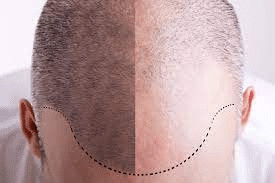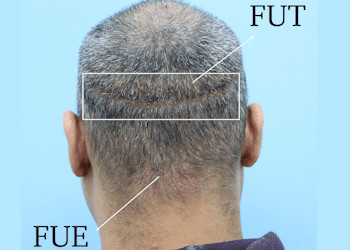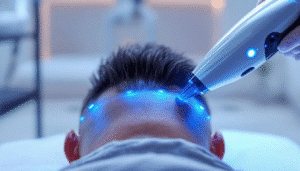The field of hair transplantation has seen significant advancements in recent years, with two main techniques dominating the market – Follicular Unit Transplant (FUT) and Follicular Unit Extraction (FUE). While FUE is often touted as a more advanced and minimal scarring technique, it has been observed that FUT continues to be the preferred choice for many patients.
In fact, FUT surpasses FUE in the number of requested procedures worldwide. This article aims to explore the reasons behind this trend and shed light on why FUT remains a top choice for hair transplantation surgeries.

An Overview of Follicular Unit Transplants vs FUE
FUT, also known as the strip method, involves removing a thin strip and extracting hair follicles from the donor area on the back of the head. The hair follicles are then dissected and implanted into the balding areas. This technique allows for a greater number of grafts to be transplanted in a single session, making it ideal for those with advanced hair loss.
On the other hand, FUE surgery involves harvesting individual hair follicles directly from the donor area using a small punch tool. These will remove individual hair follicles which are then implanted into the recipient area. While this method does not leave behind a linear scar like FUT, it is more time-consuming and can result in higher costs due to its labor-intensive nature.
Benefits of FUT Procedures
There are several benefits to opting for a FUT procedure over FUE. Firstly, the strip method allows for a larger number of grafts to be transplanted in one session, meaning that more hair can be restored in a single sitting. This is especially beneficial for those with advanced hair loss who require a greater number of grafts.
Additionally, the linear scar left by FUT is easily hidden by surrounding hair, making it virtually undetectable. This is in contrast to the multiple FUE hair transplants tiny scars left behind by FUE which can be visible if the hair is cut short.
Furthermore, because FUT involves removing a strip of tissue from the donor area rather than individual follicles, there is less risk of damage and transection to the follicles. This ensures a higher survival rate of the transplanted grafts and ultimately better results.
Moreover, FUT is typically less expensive than FUE due to its quicker and less labor-intensive nature. This makes it a more cost-effective option for patients who require a larger number of grafts.

Cost-Effectiveness of FUT Transplants
The cost of various hair transplantation methods is an important factor for many patients considering the procedure. While FUE may seem like a more advanced and modern technique, it often comes with a higher price tag due to its labor-intensive nature. FUT, on the other hand, remains one of the most cost-effective methods of hair transplantation.
One of the main reasons for this is the efficiency of FUT hair transplant procedures. As mentioned before, the strip method allows for a larger number of grafts to be transplanted in one session, meaning that fewer procedures are needed overall. This saves both time and money for patients who require a significant amount of hair restoration.
In addition, because FUT involves removing a strip of tissue rather than individual follicles, there is less time spent on harvesting and dissecting the grafts. This translates to lower labor costs for the medical team, resulting in a more affordable procedure for patients.
Moreover, FUT also has a higher success rate compared to FUE, meaning that patients are less likely to require repeat procedures or touch-ups. This can save them from additional expenses in the long run.
Preparations for a FUT Procedure
Before undergoing a FUT hair transplant, there are several preparations that patients should make. Firstly, it is important to consult with a qualified and experienced hair follicular unit transplantation FUT specialist to determine if you are a suitable candidate for the procedure.
Once approved for the surgery, it is recommended to stop smoking and avoid alcohol consumption for at least two weeks prior to the procedure. This can help improve blood flow and promote healing after surgery.
Ask Your Doctor About Current Medications & Supplements
In addition, certain medications such as blood thinners or anti-inflammatory drugs should be avoided in the weeks leading up to surgery as they may increase bleeding and interfere with healing. It is important to inform your doctor of all medications you are currently taking before undergoing any surgical procedure.
On the day of the procedure, patients should arrange for someone to drive them home as they will be under the influence of anesthesia. It is also recommended to wear loose-fitting, male pattern baldness, comfortable clothing, and avoid wearing any hair products or accessories that may interfere with the surgery.
Follow Preoperative Instructions
Patients should also follow any specific pre-operative instructions given by their doctor, such as washing their hair with a special shampoo or avoiding certain foods and beverages before the procedure.
By following these preparations and guidelines, patients can ensure a safe and successful FUT procedure. It is important to carefully follow all post-operative care instructions provided by your doctor for optimal results. By understanding the benefits and cost-effectiveness of FUT hair transplants and being well-prepared for the procedure, patients can confidently choose this method for natural-looking hair restoration.

What to Expect After a FUT Procedure
After undergoing a FUT hair transplant, patients can expect some minor discomfort and swelling in the recipient and donor areas. This is a normal part of the healing process and can be managed with prescribed pain medication.
The first few days after FUT surgery are crucial for proper healing. Patients should avoid any strenuous activities or heavy lifting during this time as it can put strain on the surgical sites.
Within 2-3 weeks, the transplanted hair will begin to fall out. This thinning hair is also a natural part of the healing process and is known as “shock loss”. However, within 3-6 months, new hair growth will start to appear from the transplanted follicles.
It is important to keep in touch with your doctor during this time and follow up appointments may be scheduled to monitor progress. Depending on the individual’s healing process, some patients may require a second procedure for touch-ups.
Patients should also closely follow any post-operative care instructions provided by their doctor. This may include avoiding certain activities or products, taking prescribed medication, and keeping the surgical sites clean to prevent infection.
At Best Hair Transplant, we understand that a professionally performed, cost-effective procedure is of top priority. Contact us to have a consultant perform your complimentary virtual or in-person consultation today!

Why We Encourage Patients to Consider FUT Solutions Over FUE Solutions
When it comes to hair restoration surgery, there are several options available for patients. However, at our clinic, we highly encourage patients to consider FUT (Follicular Unit Transplantation) solutions over FUE (Follicular Unit Extraction) solutions. This is due to the numerous benefits and advantages that FUT offers compared to FUE.
Firstly, as mentioned earlier, FUT allows for a larger number of grafts to be transplanted in one session. This means fewer procedures are needed overall, saving both time and money for patients. In addition, the linear scar left by FUT is easily hidden by surrounding hair, making it virtually undetectable. On the other hand, multiple tiny scars left behind by FUE transplants can be more visible and may require a longer healing time.
Another advantage of FUT is its higher success rate. This is because FUT grafts are taken from a strip of tissue, which contains multiple follicles, rather than individual follicles like in FUE. This means that the transplanted hair has a better chance of surviving and growing in the recipient area.
Moreover, FUT also allows for more precise placement of hair grafts as they can be carefully arranged by the surgical team. In contrast, with FUE, grafts are harvested randomly and may result in an uneven distribution of hair.
Lastly, cost-effectiveness should also be considered when choosing between FUT and FUE technique. While FUE may seem like a more advanced and less invasive FUE procedure, it often comes with a higher price tag. FUT, on the other hand, offers similar results at a more affordable cost.

Choose Best Hair Transplant
When considering a hair transplant procedure, it is important to choose a reputable and experienced clinic. At Best Hair Transplant, our team of skilled surgeons have years of experience in performing successful FUT procedures.
We also offer personalized consultations to discuss your individual needs and goals for hair restoration. Our goal is not only to provide excellent results but also to ensure the comfort and satisfaction of our patients throughout the entire process.
In addition, we pride ourselves on offering affordable prices without compromising on quality. We understand that hair loss can be emotionally taxing and we want to make sure that financial concerns do not hinder anyone from achieving their desired results.
If you are considering a hair transplant procedure, look no further than Best Hair Transplant. Contact us today for a free consultation and to learn more about our services. Don’t let hair loss hold you back any longer, trust Best Hair Transplant for all your hair restoration needs. So why wait? Schedule your consultation today and take the first step towards a fuller head of hair! 213-403-0455.
FAQS
What is a follicular unit transplant (FUT) and how does it differ from FUE hair transplantation?
A Follicular Unit Transplant (FUT) hair transplant method is a hair restoration procedure that involves removing a strip of donor hair from the back of the scalp and dissecting it into individual follicular units for transplantation. In contrast, FUE transplant involves the extraction of individual high hair follicle density from the donor area. FUT and FUE are both fue hair transplant surgery techniques, but they differ in the method of hair extraction.
How is donor hair selected and harvested in a follicular unit transplant FUT procedure?
In an FUT hair transplant procedure, the donor hair is typically selected from the back or sides of the scalp, areas of scalp skin that are less prone to hair loss. A strip of scalp containing hair follicles is surgically removed and then dissected into individual follicular units under a microscope. These units are subsequently transplanted into the recipient area where hair restoration is desired.
What are the advantages of a follicular unit transplant (FUT) over other hair transplant methods, and in what situations is it recommended?
FUT offers several advantages, such as the ability to transplant a large number of grafts in a single session and a high success rate. It is recommended for individuals treating hair loss or those seeking maximum hair coverage. FUT is also suitable for those who have a well-defined and stable donor area on the scalp.
What should one consider when contemplating a follicular unit transplant (FUT) procedure?
When considering an FUT hair transplant, individuals should think about factors like scarring (which can be concealed with longer hair), potential discomfort during recovery, and the need for some downtime. After the surgery, patients can expect a recovery period of a few weeks, during which they may experience some swelling and discomfort. However, with proper care and follow-up, the transplanted hair will gradually grow, providing natural and lasting results.

